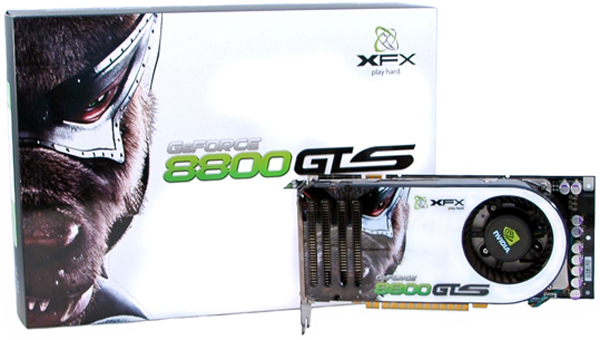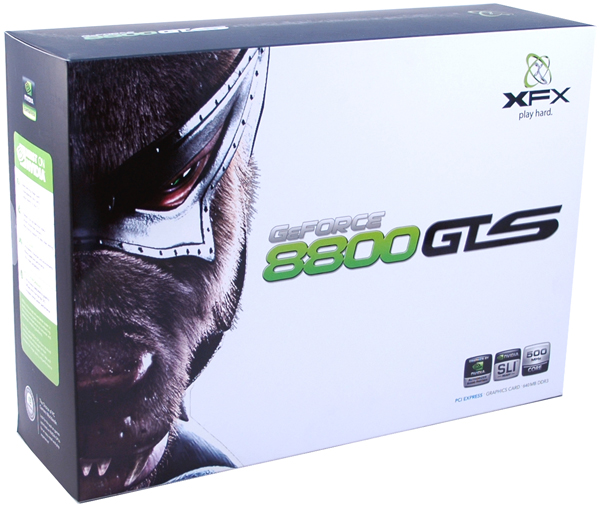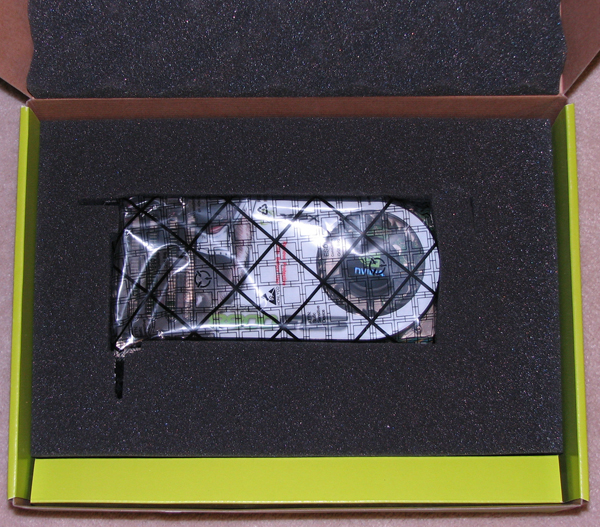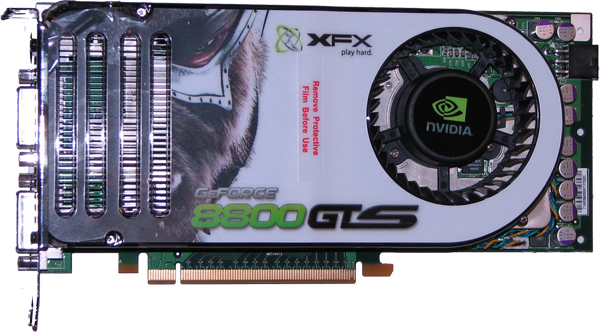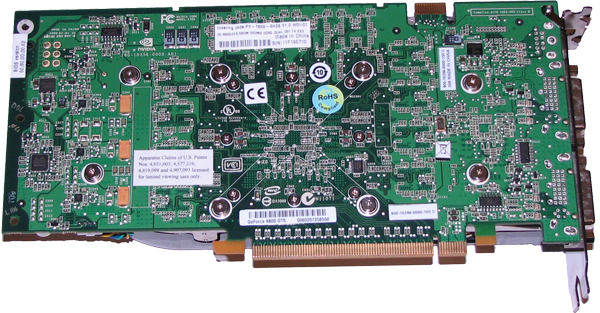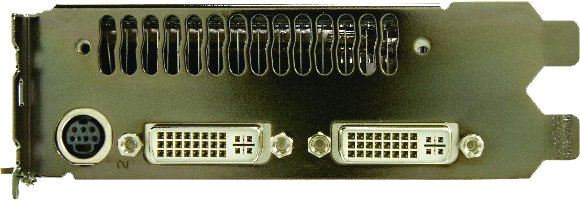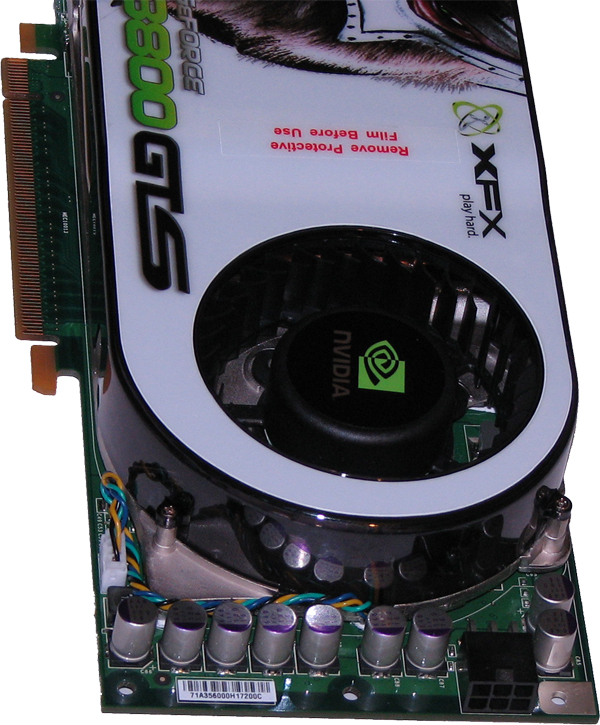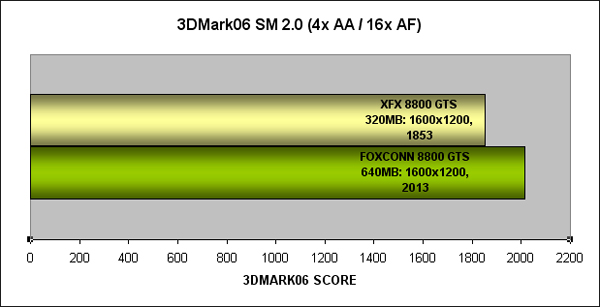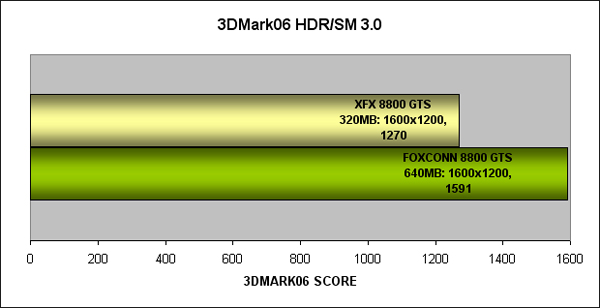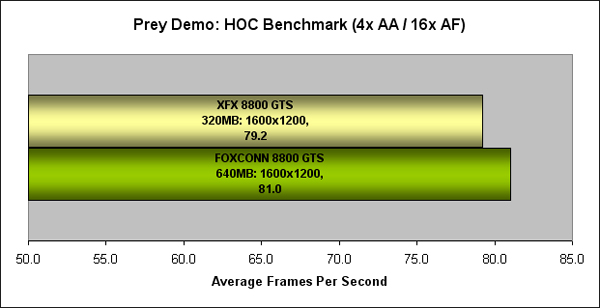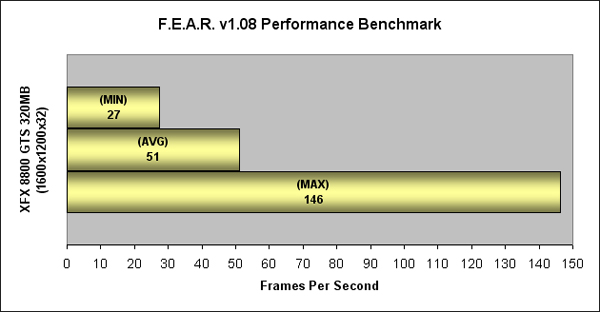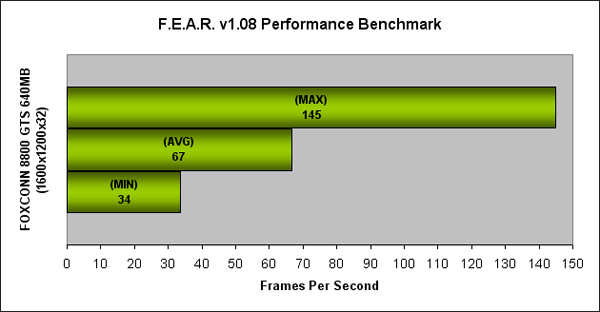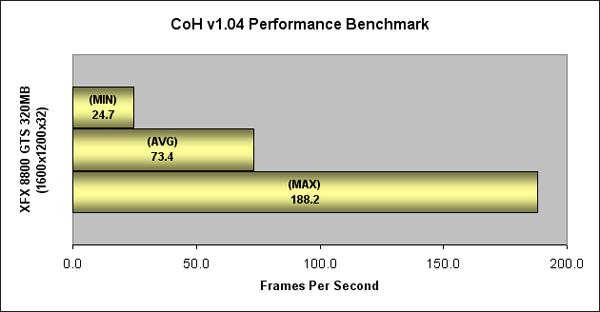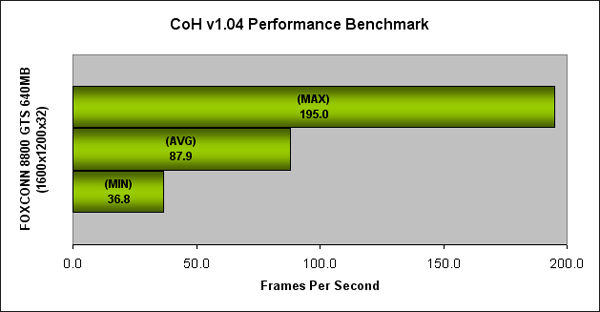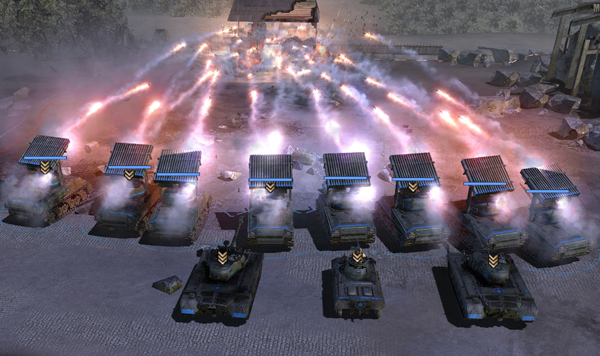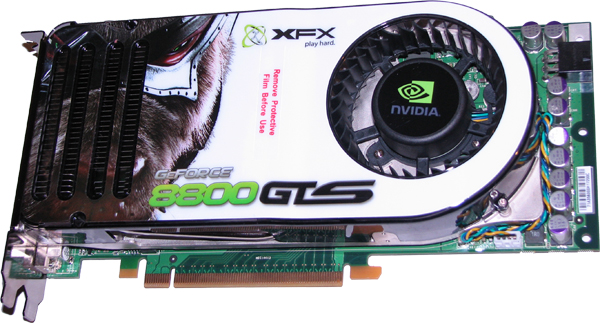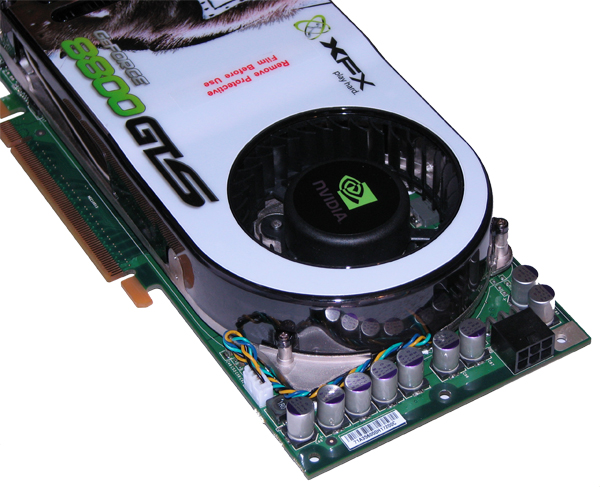In a continuation from the exclusive GeForce 8800 series product launch covered by Bjorn3d.com here, NVIDIA has added some new spice to the plate with the introduction of a value-priced GeForce 8800 GTS video card featuring a 320MB video frame buffer. Build on the exact same high performance platform as the previous 640MB version, this new edition to the family offers all of the same great performance and almost half the cost.
INTRODUCTION
In a continuation from the featured GeForce 8800 series product launch covered by Bjorn3d.com, NVIDIA has added some new spice to the plate with their introduction of a new value-priced GeForce 8800 GTS video card featuring a 320MB video frame buffer. Built on the exact same high performance platform as the previous 640MB version, this new edition to the family offers all of the same great performance at almost half the cost.
Key features:
- NVIDIA® unified architecture with GigaThread TM technology
- Full Microsoft® DirectX® 10 Shader Model 4.0 support
- NVIDIA® SLI Ready
- 16x full-screen anti-aliasing
- True 128-bit floating point high dynamic-range (HDR) lighting
- NVIDIA® Quantum Effects physics processing technology
- Two dual-link DVI outputs support two 2560×1600 resolution displays
- NVIDIA PureVideoTM technology
- PCI Express® Support
- OpenGL® 2.0 support
- NVIDIA® ForceWare® Unified Driver Architecture (UDA)
- Built for Microsoft® Windows Vista
NVIDIA® unified architecture with GigaThread™ technology
Massively multi-threaded architecture supports thousands of independent, simultaneous threads, providing extreme processing efficiency in advanced, next generation shader programs.
NVIDIA® Lumenex™ Engine
Delivers stunning image quality and floating point accuracy at ultra-fast frame rates.
Full Microsoft® DirectX® 10 Support
World’s first DirectX 10 GPU with full Shader Model 4.0 support delivers unparalleled levels of graphics realism and film-quality effects.
Dual 400MHz RAMDACs
Blazing-fast RAMDACs support dual QXGA displays with ultra-high, ergonomic refresh rates–up to 2048×1536@85Hz.
Dual Link DVI
Capable of supporting digital output for high resolution monitors (up to 2560×1600).
NVIDIA® SLI™ Technology
Delivers up to 2x the performance of a single GPU configuration for unparalleled gaming experiences by allowing two graphics cards to run in parallel. The must-have feature for performance PCI Express graphics, SLI dramatically scales performance on over 60 top PC games.
PCI Express™ Support
Designed to run perfectly with the next-generation PCI Express bus architecture. This new bus doubles the bandwidth of AGP 8X delivering over 4 GB/sec. in both upstream and downstream data transfers.
16x Anti-aliasing
Lightning fast, high-quality anti-aliasing at up to 16x sample rates obliterates jagged edges.
NVIDIA® PureVideo™ Technology
The combination of high-definition video processors and NVIDIA DVD decoder software delivers unprecedented picture clarity, smooth video, accurate color, and precise image scaling for all video content to turn your PC into a high-end home theater. (Feature requires supported video software.
OpenGL™ 2.0 Optimizations and Support
Ensures top-notch compatibility and performance for all OpenGL applications. NVIDIA® nView® Multi-display Advanced technology provides the ultimate in viewing flexibility and control for multiple monitors.
NVIDIA® nView® Multi-Display Technology
Advanced technology provides the ultimate in viewing flexibility and control for multiple monitors.

About the company: XFX
Since XFX is so well known in the industry, it may come as a surprise to know that it is actually a division of another company: Pine Technology, Inc.
XFX dares to go where the competition would like to, but can’t. That’s because, at XFX, we don’t just create great digital video components – we build all-out, mind-blowing, performance crushing, competition-obliterating video cards and motherboards. Oh, and not only are they amazing, you don’t have to live on dry noodles and peanut butter to afford them.
Founded in 1989, PINE Technology designs, develops, manufactures and distributes high-quality digital audio and video devices as well as computer peripherals. PINE also distributes branded computer and communications products. The company’s movement into areas such as global B2B eCommerce and software development have helped keep it ahead of the competition. Today, PINE enjoys strategic alliances with companies such as Dell, NEC, Microsoft, Panasonic, Phillips, Ricoh, Samsung, Ingram Micro, Intel, Quantum, Connertech, Pioneer and Fujitsu.
Headquartered in Hong Kong, PINE Technology has more than 1,000 employees worldwide, with 16 offices around the globe, four research and development centers strategically located in the Asia Pacific region, and two factories in China.
Production output at PINE’s factories exceeds an impressive 500,000 units of PC components and I.A. appliances per month. However, our line flexibility enables us to switch lines within a scant four hours to expand capacity to a staggering one million board-level products per month.
CLOSER LOOK: XFX GeForce 8800 GTS 320MB XXX Edition
Unlike video cards of yesteryear, the differences inside are not nearly as obvious when examined from the outside. At first glance, the XFX 8800 GTS 320MB version is no different then every other 8800 GTS.
XFX has teamed up with NVIDIA to deliver the same phenomenal performance found in the GeForce 8800 GTS series with a reduced video frame buffer of 320MB. This combination allowes mid-level buyers the ability to afford outstanding performance with very little compromise.
For reasons unknown to me, the big bad wolf always seems to make his appearance on the cover of XFX video card products. Some creative minds, those XFX artists.
Unlike other manufacturers who would attempt to shroud their product in cardboard or plastic, XFX knows that the easiest way to prevent defective returns is to protect the product until it reaches the consumers hands. Each XFX GeForce 8800 GTS is packaged in very protective open-cell foam.
Identical in every perceivable way to the 640MB version of the GeForce 8800 GTS, this XFX 320MB version offers all of the same great cooling and design features at a much more affordable price.
Utilizing the green PCB in their design of the XFX GeForce 8800 GTS, the electronics are laid out in exactly the same fashion as other versions of this product. The product SKU indicates that this is XFX’s “XXX” version of the card. The triple-X implies that this video card is factory overclocked. Interesting model name designation, though. So far this product hasn’t displayed anything of an adult nature outside of the overall performance.
Conforming to the standards previously set by the 640MB version of the GeForce 8800 GTS, the I/O panel features dual link DVI ports and a seven-pin VIVO dongle connection. The anodized gunmetal bracket completes the “strictly business” appearance.
Unlike some other manufacturers, XFX choose to avoid features such as stick-on LED light strips inside the fansink housing. I am thankful for this, because they caused problems in both of the other 8800 GTS video cards I own. After the card would heat up, the LED light strip would loose its adhesive quality and peel up, impeding the blower fan. Put simply: XFX recognizes function over additional fashion.
Cooled by the DELTA BFB1012L blower fan
A single 12V power connection is required to operate the 8800 GTS series, which means that your power supply does not have to be rated for SLi in order to use this video card. This is one of the features which separate the GTS series from the more expensive and more demanding GTX series.
The DELTA BFB1012L blower fan operates very quietly, with light sounds only at startup. Although there is no noticeable speed control programmed into the fan, I was able to make use of the NVIDIA nTune application to control fan speed and raise (or lower) output from the default value of 60% power through the direct fan control applet.
TESTING: SETUP
In order to complete a thorough review of the XFX GeForce 8800 GTS 320MB, it is imperative that the audience understand how each test was conducted and what factors influenced the results. Please note that benchmarks and test scores are always relative to the conditions and hardware present at the time of testing. Even if you have my exact same system, the scores may be close but will never be the same.
It should be noted that after testing with the FOXCONN GeForce 8800 GTS 640MB video card using ForceWare driver v97.92, I utilized Driver Cleaner Pro to remove all trace of the driver prior to loading ForceWare v97.92 again for the XFX GeForce 8800 GTS.
Test System
- Motherboard: ABIT AB9 Pro v1.5 BIOS (Intel 965 chipset)
- Processor: Intel E6600 Core 2 Duo 2.2GHz operating at 3.0 GHz (334 MHz FSB)
- Cooling: Thermalright HR-01 heatpipe CPU cooler with 120mm fan
- Memory: 2 GB (1,024 MB x2 modules) Corsair CM2X1024-6400C4 DDR2 SDRAM @ 835MHz
- Video #1: FOXCONN GeForce 8800 GTS 640MB operating at 600MHz Core and 900MHz RAM
- Video #2: XFX GeForce 8800 GTS 320MB operating at 580MHz Core and 900MHz RAM
- Audio Device: HT Omega 7.1 C-Media 8788 Oxygen Chipset
- Hard Disk 1: Western Digital WD360GD 10,000 RPM SATA
- Optical Drive: Lite-On SH-16A7S-05 SATA DVD R/W
- Enclosure: Lian Li PC-B20A ATX Case with 2x120mm and 1x90mm cooling fans
- Operating System: Windows XP Professional SP-2 with IE7
Benchmarks
• 3DMark06 SM 2.0 Test (4x Anti Aliasing & 16x Anisotropic Filtering)
• 3DMark06 HDR/SM 3.0 Test (4x Anti Aliasing & 16x Anisotropic Filtering)
• Company of Heroes v1.04 Performance Test (Maximum Settings: Shadow Quality High, AA Enabled, Texture Detail Ultra)
• F.E.A.R. v 1.08 Performance Test (Maximum Settings: 4x Anti Aliasing & 16x Anisotropic Filtering)
• Doom 3 v1.3: Timedemo Demo1 Benchmark (Ultra Quality Settings: 4x Anti Aliasing)
• Prey Demo: HOC/Guru3D Benchmark (Maximum Settings: 4x Anti Aliasing & 16x Anisotropic Filtering)
Testing Methodology
I will be testing and comparing the FOXCONN GeForce 8800 GTS 640MB against the XFX GeForce 8800 GTS 320MB XXX. The XFX GeForce 8800 GTS 320MB XXX version will become the third best video card available as of 02/12/2007; and rightfully so since it holds all of the same processor power with exactly half the amount of video RAM. In all of the benchmarks to follow, I will demonstrate the power of the 8800 GTS series.
The synthetic benchmark tests in 3DMark06 will not be configured to run the default tests, primarily because doing so will factor in a battery of CPU tests into the final score. Since everything is relative and subjective in reviews, I choose to concentrate my efforts on benchmarking the video cards, and not skew results with my high-end processor. Every test was conducted at 1600×1200 resolution, which is the native resolution for a 20.1″ LCD display and probably one of the most widely used screen resolutions for gaming. Each test shall be run after a system restart, and then the first test for each benchmark will be ignored. This process proved extremely important in the Doom 3 benchmark, as the first run served to cache the demo; subsequent tests performed twice as well as the first. Each test will be run in succession three times.
Since all of these benchmarks represent different gaming engine technology and graphic rendering processes, I feel that this battery of tests will provide a diverse range of tests for you to gauge performance. Unfortunately, at the time of this writing there are no DirectX 10 games available for benchmarking, so DirectX 9 versions were used for all tests. Additionally, there are no Shader Model 4.0 testing tools available to the general public, so 3DMark06 v1.1.0 was utilized for SM2.0 and 3.0. Moving on…
TESTING: LIGHT BENCHMARKS
Grouped into two separate categories, I have assembled a battery of benchmark tests based on their demand of the video card. It should be noted that the first results of every test were thrown out, and the average of the three subsequent tests are displayed. Please also note that the higher the score and frames per second in each chart, the better. Without further delay, here are the light stress benchmarks:
3DMark06 Shader Model 2.0
In the synthetic benchmarks performed with 3DMark06 v1.1.0, the GeForce 8800 GTS 640MB version out-performed the XFX GeForce 8800 GTS 320MB XXX Edition by only 60 points in the Shader Model 2.0 tests. Despite half the amount of video RAM and a 20MHz lower core clock, the XFX GeForce 8800 GTS 320MB version manages to keep in step with the more expensive variant.
3DMark06 Shader Model 3.0
Just as it did with the Shader Model 2.0 tests, the SM 3.0 benchmark concludes that the FOXCONN GeForce 8800 GTS 640MB is slightly more powerful then the XFX 320MB version. Hopefully 3DMark07 will incorporate Shader Model 4.0 tests when it is released, so that Bjorn3d can follow up on the progress.
Prey Demo
Not much surprise in the Prey Demo results, which begin to indicate that the FOXCONN GeForce 8800 GTS 640MB version just barely outperforms the XFX GeForce 8800 GTS 320MB version using the older game engine. These results were based on the Guru3D demo on the free HOC benchmark tool.
Doom 3 Timedemo
In the Doom 3 tests, the difference is almost negligible, but it is still there. As you will see in the more stressful benchmarks, the FOXCONN GeForce 8800 GTS just barely outpaces the XFX GeForce 8800 GTS 320MB version. If you would like to duplicate this test with your own installation of Doom 3 v1.3, simply open the command console by pressing CTRL+ALT+~, and type in “timedemo demo1”. Make sure to allow the first demo to run, which caches the files, before you begin recording your own results.
TESTING: HEAVY BENCHMARKS
Don’t let the title fool you, these tests will hardly tax the GeForce 8800 GTS series, but they are what I would consider the most aggressive tests available. The only reason they are labeled heavy is because there is nothing more taxing available to benchmark this product at the time of this writing.
FEAR v1.8 on the XFX GeForce 8800 GTS 320MB XXX Edition
FEAR v1.8 on the FOXCONN GeForce 8800 GTS 640MB
Despite my obvious lack of mastery when it comes to building charts, I believe you will see the three recorded levels to be easily comparable between the two cards. While there aren’t any real differences at the maximum FPS range, the minimum FPS range shows what kind of difference the extra RAM can make. Having twice as much RAM available in the FOXCONN GeForce 8800 GTS 640MB version clearly plays a role in these figures.
Company of Heroes v1.4 on the FOXCONN GeForce 8800 GTS 640MB
As indicated by the benchmarks above, the XFX GeForce 8800 GTS 320MB version is unable to maintain at least 30 frames per second in for the minimum frame rate. Most gamers would consider anything under this average to be unplayable, so this test has shown that there are limitations for the XFX GeForce 8800 GTS 320MB series. At 1600×1200 resolution in what is probably the most demanding test and settings out of the entire battery of benchmarks, both cards did very well. The evidence has shown that video RAM is important, and will make a noticeable impact in the numbers.
While 320MB of video RAM may be more then sufficient to play almost every DirectX 9 game available at the highest settings, once DirectX 10 games meet the market the significance of more video RAM will have a large impact on the maximum frame rate under the harsh conditions created by Shader Model 4.0.
Company of Heroes with the GeForce 8800 GTS (Click for large image)
At the end of all the benchmarks, it was time for me to give the XFX GeForce 8800 GTS 320MB a taste of real world usage. I have been playing Company of Heroes for a few months now with the FOXCONN GeForce 8800 GTS 640MB, and when I switched to XFX’s 320MB version I experience no noticeable loss of performance. I think I picture really is worth a thousand words, and this one does the video card real justice.
CONCLUSION
To be honest, I didn’t expect the video frame buffer to make a very big impact. Certainly, the 320MB frame buffer offers great value to the powerful 8800 GTS video processor; but for those hardcore gamers utilizing the highest settings with full anti-aliasing and anisotropic filtering support then the 640MB version is most suitable.
I was surprised to see so much of a difference in benchmark results because of video RAM. With a mere 20MHz lower GPU speed, I really expected only very minor differences in scores. The XFX GeForce 8800 GTS 320MB XXX Edition video card had no problem matching performance in the less demanding games, such as Doom 3 and Prey. But it did not perform quite as well as the GeForce 8800 GTS 640MB by a larger margin in the minimum frame rates for newer games (on their highest settings).
EDITORS NOTE: It is my feeling that the product is essentially performing as it was designed. IMHO, one cannot expect the same performance at any high-performance level from a graphics card utilizing 320 MB of memory as opposed to the same card equipped with 640 MB … Scott Sherman, Owner/Publisher Bjorn 3D.
Because my testing offered a comparison under moderately demanding video settings, it seems clear now that the 640MB variant of the 8800 GTS pushes ahead at the lower and middle-end better then the 320MB version; all thanks to the amount of video RAM. Regardless of the test or the size of frame buffer, both GeForce 8800 GTS versions posted high numbers in every test. With F.E.A.R. and CoH applying the most pressure to this card, even these tests received outstanding results.
Since it is certain to be a topic of later discussion, I found this specific model to not offer much for overclockers. Using ATITool v0.26 final, I was not able to exceed the 900MHz RAM clock speed without causing artifacts; in fact ATITool lowered the memory clock speed down to 870MHz before artifacts were altogether non-existent. Utilizing the default RAM speed, the GPU clock speed could be raised to only 610MHz before artifacts occurred. Perhaps better results could be had using alternative cooling methods, but I personally feel that they would not be worthwhile.
Because the XFX 8800 GTS 320MB version will be the third best video card available at the time of launch, I believe it will cater to the larger segment of the market who want a great video card with outstanding performance without the high pricing found in the superior version. It is expected that the XFX GeForce 8800 GTS 320MB XXX (SKU: PV-T80G-GHD9) will retail for $334.99 USD at the time of release. XFX Plans on releasing a total of three 8800 GTS/320MB version:
PVT80GGHF9: $299.99
PVT80GGHE9 (Extreme Edition): $309.99
PVT80GGHD9 (XXX Edition): $334.99
Installation was a breeze, with no special tools or connectors required. Since the GeForce 8800 GTS measures only 9 inches long, I had no problem at all installing this card into my rather confined Lian Li PC-B20A mid-tower case. As mentioned previously in this review, all models of the GeForce 8800 GTS series use two card slots and a single PCI-Express slot. It requires only one six-pin 12V connection, and can be used in an SLi configuration if it is desired.
Since the XFX GeForce 8800 GTS 320MB XXX does not require an SLi capable power supply unit, and it costs nearly $100 less then the more expensive 640MB version, I believe this will be the choice for gamers who are not able to purchase “King of the Hill” rights but still keep performance at the forefront. Without speculating too much on proposed yet-to-be-released lower-end models, I can safely say that the 320MB version will fulfill all current gaming needs with excellent performance while offering a competent solution to DirectX 10 and Shader Model 4.0 gaming.
Since my initial review of the FOXCONN 8800 GTS 640MB, I have had made some notes regarding the cooling fan operation utilized in the GeForce 8800 series. For the most part, the new “fansink” designed and used by NVIDIA for these video cards is great. However, I have noticed that there have been times where I hear very distinct clicking sounds coming from the fan. Although the fan operation is not impacted, I fear that the this may be an inherant by-product of these fans over time.
In the case of the XFX 8800 GTS, the DELTA BFB1012L fan operated at a very low sound level the entire time, keeping the GPU at 62° to 64° Celsius range at idle and 86° to 90° Celsius range under full load. Obviously NVIDIA paid attention to the complaints surrounding the previous generation of video cards by up scaling the cooling to a heatpipe-equipped solution; yet the new 8800 series still generates its own fair share of heat.
Pros:
+ Less expensive performance alternative
+ Supports DirectX 10 and Shader Model 4.0
+ Impressive stock cooling solution
+ High Dynamic Range Rendering (HDR) compliant
+ 3rd best video card available at time of writing
+ Bundled with Tom Clancy’s Ghost Recon: Advanced Warfighter
+ SLi certified and expandable
+ XFX Exclusive Double-Lifetime warranty protection
Cons:
– Not much overclocking potential
– Driver support for Windows Vista is still immature
Final Score: I rate the XFX GeForce 8800 GTS 320MB XXX Edition with a final score of 8.5 (Extremely Good) out of 10, and recommend the prestigious Bjorn3d.com Seal of Approval.
Special Thank-you:
This review would not be possible if it weren’t for manufacturers like XFX, who are willing to risk their name and reputation to have a picky hardware analysts like me dissect their product. I am grateful, and certainly appreciate the opportunity.
 Bjorn3D.com Bjorn3d.com – Satisfying Your Daily Tech Cravings Since 1996
Bjorn3D.com Bjorn3d.com – Satisfying Your Daily Tech Cravings Since 1996

